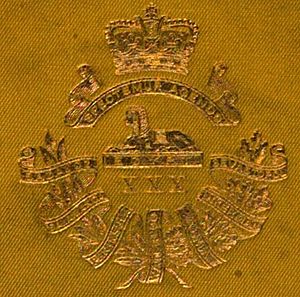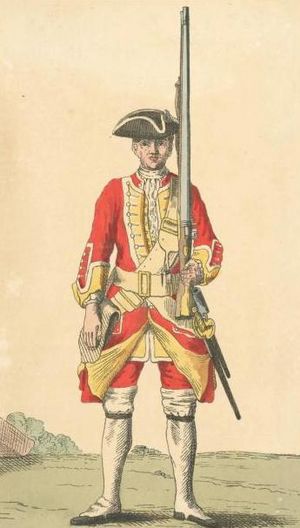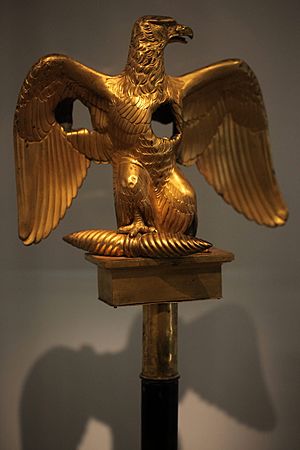30th (Cambridgeshire) Regiment of Foot facts for kids
Quick facts for kids 30th (Cambridgeshire) Regiment of Foot |
|
|---|---|

Badge of the 30th (Cambridgshire) Regiment of Foot
|
|
| Active | 1702–1881 |
| Country |
|
| Branch | |
| Type | Line infantry |
| Garrison/HQ | Burnley Barracks, Burnley |
| Nickname(s) | The Triple X's |
| Colors | Pale yellow facings |
| Engagements | Capture of Gibraltar French campaign in Egypt and Syria Peninsular War Napoleonic Wars Crimean War |
The 30th (Cambridgeshire) Regiment of Foot was a British Army infantry regiment. It was first formed in 1702. An infantry regiment is a group of soldiers who fight on foot.
This regiment was known by different names over the years. It was finally combined with another regiment in 1881. This happened because of big changes in the army called the Childers Reforms. The new group was named the East Lancashire Regiment.
Contents
History of the 30th Regiment
Early Years and First Battles
The regiment started in 1689 as 'Lord Castleton's Regiment of Foot'. This was during a war called the Nine Years' War. They traveled to a place called Flanders in 1691.
After the war ended in 1697, the regiment was temporarily closed down. But in 1702, a new war started, the War of the Spanish Succession. The regiment was brought back to life as 'Thomas Sanderson's Regiment of Marines'.
They helped capture and defend Gibraltar in 1704. They also took part in capturing Barcelona in 1705. The regiment's name changed a few times, depending on who was in charge.
Serving in Europe and Beyond
In 1714, the regiment became a regular infantry unit. They were sent to Ireland and later to Menorca and Gibraltar for guard duty.
During the War of the Austrian Succession, they went on an expedition to France in 1746. They tried to capture the port of Lorient. Some soldiers also served as marines on ships during a big naval battle in 1747.
Becoming the 30th Regiment
On July 1, 1751, a new rule changed how regiments were named. They would no longer be named after their colonels. Instead, they got a number. So, they became the 30th Regiment of Foot.
This rule also set the uniform colors. The 30th Regiment wore red coats with pale yellow parts. During the Seven Years' War, they took part in raids on French ports. Their most famous action was capturing Belle Île in 1761.
American War of Independence
In 1781, the regiment sailed to North America. They arrived in Charleston, South Carolina, to fight in the American War of Independence.
After the war, they spent nine years in the Caribbean. In 1782, the regiment was given a county name. It became the 30th (Cambridgeshire) Regiment of Foot. In 1791, they helped stop a rebellion in the Caribbean.
Fighting in the Napoleonic Wars
The regiment returned to England in 1791. They helped French royalists during the French Revolutionary Wars in 1793. In 1801, they went to Egypt to fight the French army there. They fought in the Battle of Alexandria.
In 1803, the regiment formed a second battalion. A battalion is a large group of soldiers. The 1st Battalion went to India and stayed there for many years.
The 2nd Battalion went to Portugal in 1809 for the Peninsular War. They fought bravely at the Siege of Badajoz in 1812. They lost many soldiers there.
They also fought at the Battle of Salamanca in 1812. Here, a young officer named Ensign John Pratt captured a special French flag. This flag was called a French Imperial Eagle. It was a great honor to capture one.
The 2nd Battalion later fought in the famous Battle of Waterloo in June 1815. At Waterloo, the 2nd Battalion of the 30th Regiment formed a defensive square. They stood strong against many French attacks.
The 2nd Battalion was disbanded in 1817. The 1st Battalion, still in India, fought in the Third Anglo-Maratha War. They returned to England in 1829.
Later Years and Amalgamation
The regiment served in various places like Ireland, Bermuda, and Canada. In 1854, they went to the Crimean War. They fought in important battles like the Battle of Alma and the Battle of Inkerman. They also took part in the Siege of Sevastopol.
In 1861, the regiment moved to Canada. They helped defend against attacks from a group called the Fenians.
In 1881, big changes happened in the British Army. These were called the Childers Reforms. The 30th Regiment was combined with the 59th Regiment. Together, they formed a new regiment called the East Lancashire Regiment. This marked the end of the 30th (Cambridgeshire) Regiment of Foot as a separate unit.
Battle Honours
Battle honours are special awards given to regiments for their bravery in battle. They are often displayed on the regiment's flags. The 30th Foot earned several important battle honours:
- Napoleonic Wars:
* Badajoz (1825) * Salamanca (1830) * Peninsular (1815) * Waterloo (1815) * The sphinx symbol with "EGYPT" written below it (1802)
- Crimean War:
* Alma (1855) * Inkerman (1855) * Sevastopol (1855)
Victoria Cross
The Victoria Cross is the highest award for bravery in the British military.
- Lieutenant Mark Walker received the Victoria Cross during the Crimean War on November 5, 1854.




